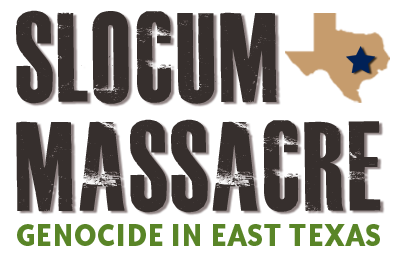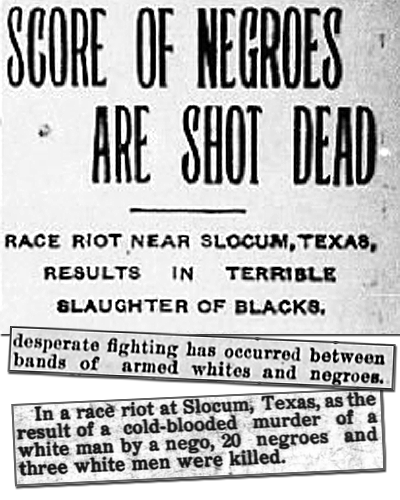 One of our most read “This Day in History” posts is about the July 29, 1910, Slocum Massacre — the racially charged murders by whites on the Black population of Slocum, Texas, and the subsequent cover-up of a community’s violent history.
One of our most read “This Day in History” posts is about the July 29, 1910, Slocum Massacre — the racially charged murders by whites on the Black population of Slocum, Texas, and the subsequent cover-up of a community’s violent history.
In the book The 1910 Slocum Massacre: An Act of Genocide in East Texas, E. R. Bills presents this little-known history and its context: white anger fueled by insecurity and envy; racist attitudes contributing to a violent mob mentality; and a history of lynchings with known participants not held accountable. In the aftermath, Bills explains, “The abandoned African American properties were absorbed or repurposed as the remaining white population saw fit. The standard Southern Anglocentric world order was restored, and this order has endured, even to the present day.”
Slocum does not stand alone as an incident of racist violence in which whites, determined to thwart African American economic or political progress, employed overwhelming force to maintain the racial status quo. Tulsa, Oklahoma, and Rosewood, Florida, are prominent examples. But it may also be that the Slocum “This Day in History” post is widely read because this resonates powerfully with our own time. Even a casual observer of the recent Republican National Convention could sense the powerful undercurrent of white anxiety and fear. Slocum, Tulsa, and Rosewood stand as cautionary tales about the explosive and violent potential of people who feel on the verge of losing their privilege. And the sickening regularity of police murders of African Americans also pulls the issue of white-on-Black violence into our own time.
Slocum is one piece of the hidden history of our past. But the Zinn Education Project also features numerous examples of solidarity across racial lines. And it’s the possibility of racial justice embedded in this solidarity that helps us envision a different, better society. We need to learn from history — all of it: that which inspires horror, but also that which inspires hope.
______________________________________________________________
July 29, 1910: Slocum Massacre in Texas
By E. R. Bills
The 1910 Slocum Massacre in East Texas officially saw between eight and 22 Blacks killed, and evidence suggests African American casualties were 10 times these amounts. Yet the massacre has become a dirty Lone Star secret, remarkable more for the inattention it has received than for its remembrance.
Unlike most Texas communities in the early 20th century, the unincorporated town of Slocum — like Rosewood, Florida — was largely African American, with several Black citizens considerably propertied and a few owning stores and other businesses. This alone, in parts of the South, might have been enough to foment violence. But in the area around Slocum, roughly 100 miles east of Waco, there were other issues, according to newspaper reports and other sometimes conflicting accounts of the massacre.







Twitter
Google plus
LinkedIn